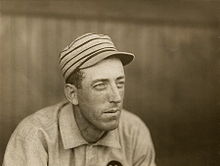Tagged: Eddie Plank
Randy Johnson Signs His “Eddie Plank” at Hotel Check-In
By Glen Sparks
Randy Johnson has to be one of the most recognizable people in the country, in sports or otherwise. Six-feet-10-inches tall, perpetual scowl … mullet.
That still didn’t keep him from pulling a fast one on the hotel people in New York. The Big Unit flew out to the Big Apple for his Hall of Fame press conference, along with Craig Biggio, Pedro Martinez and John Smoltz. He checked into the Waldorf Astoria as Eddie Plank.
And, most assuredly, he did not pick that name randomly. Plank was sort of the Randy Johnson of his day.
Ok, we’ll get a few things out of the way first. Plank stood almost a foot shorter than Johnson, at 5-11. And he did not sport a mullet. I have seen several pictures of Plank, though, and he did have a decent scowl.
More to the point, Plank, like Johnson, was a left-hander. He, like the Unit, was one of the most dominant pitchers of his era. He won 326 games in his 17-year career, or 23 more games than Randy did in a 22-year career.
“Gettysburg Eddie,” born in that Pennsylvania town just 12 years after the famous Civil War battle, spent most of his career with Connie Mack’s Philadelphia A’s. He won at least 20 games eight times and after posting a 3.31 in his rookie season of 1901 and 3.30 in his sophomore campaign never had an ERA above 2.87 for the rest of his career.
Plank baffled hitters with sidearm curveballs and fastballs. A SABR article written by Jan Finkel asserts that Plank swore by an elaborate routine on his every pitch to the plate. He would fix his cap, adjust his shirt, rub up the baseball, etc. He was, at least at the start of his career, the No. 2. pitcher on the A’s staff, behind the fireballing, and rather eccentric Philadelphia ace, Rube Waddell.
Plank’s best year was probably 1904. He went 26-17 with a 2.17 ERA in 357.1 innings. He had a WAR of 8.5 that season. Plank tossed seven shutouts, seven of the 69 he threw in his career, fifth all-time and first among left-handers. Gettysburg Eddie also hit 19 batters in 1904. The man with a reputation for plunking batters hit a grand total of 190 hitters. He is tied for fifth all-time. Which other pitcher left his mark on 190 batters in his career? Oh, yes, Randy Johnson.
Eddie left the A’s following the 1914 season, jumping ship to the St. Louis Terriors of the Federal League. St. Louis finished first, and Plank led the way. He went 21-11 with a 2.08 ERA, leading the league in ERA+ (153) and WHIP (0.991).
Phil Ball, owner of the Terriers, subsequently bought the Browns and retained Plank, who went a combined 21-21 in two seasons with St. Louis’s American League club. Plank retired after the 1917 campaign. Always a bit high-strung, he cited stomach problems for his decision to hang up his glove and spikes. He would be happy to go back to his farm in Gettysburg, he said.
Plank died from complications of a stroke on Feb. 24, 1926. He was just 50 years old. He was buried in Gettysburg.
Plank was 326-194 as a big-league pitcher with a 2.35 ERA. He was the first-lefty win at least 300 games in his career. He remains 13th on the all-time wins list, two wins ahead of Nolan Ryan and Don Sutton. His career ERA ranks 21st all-time. In seven World Series starts, Plank went just 2-5, but he had a 1.32 ERA.
In truth, Johnson, who pitched for six teams in his career, was a better pitcher than Plank. Eddie won a few more games while pitching in an era when winning 25 or 30 games wasn’t headline news. He had a lower ERA when 2-1 and 3-2 games were the norm. His ERA+ for his career was 122, despite that shiny 2.35. The “black-ink test” is something that many baseball analysts use to judge ballplayers. Plank finished with 15 black-ink points; the average Hall of Fame pitcher has 40.
Randy Johnson went 303-166 with a 3.29 ERA during maybe the most prolific offensive era in baseball history. He had an ERA+ of 135 and led the league in that category six times. He also struck out 4,875 batters in his career, second to Nolan Ryan. The Unit topped the league in strikeouts nine times. He had 99 black-ink points, sixth all-time.
Johnson was elected to the Hall of Fame on the first ballot with 97.3 percent of the vote. Plank went into Cooperstown in 1946, selected by the Old-Timers Committee.
So, even if Randy Johnson outdid Eddie Plank, we should still thank the Unit for not forgetting one of baseball’s other all-time greats.
